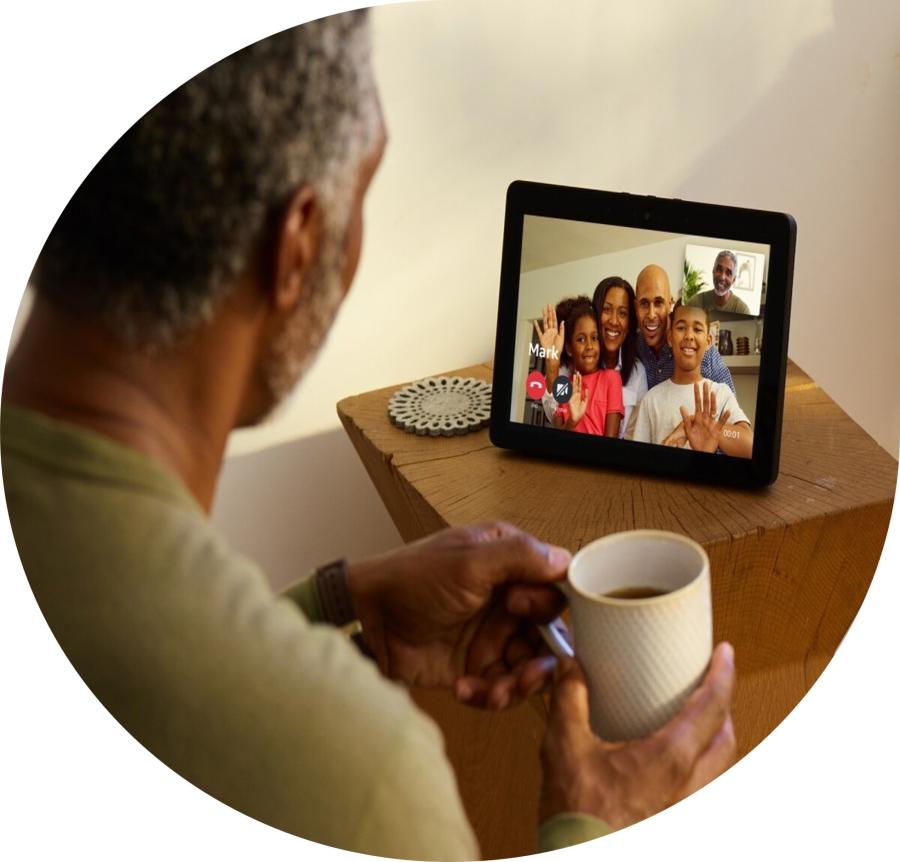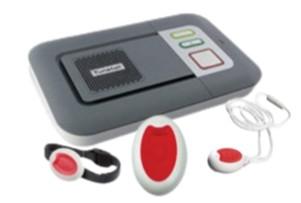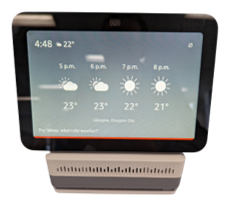The Connected Care and Wellbeing project aims to test Amazon Alexa smart speakers as alternative alert devices to the telecare industry’s existing digital offerings, with the long-term goal of establishing their use as proactive telecare unit

What is the Problem
Telecare services support independent and safe living for individuals, particularly those with health conditions, disabilities, or the elderly who may be at risk. These services rely on technology such as sensors, alarms, and monitoring devices to detect emergencies or changes in a person’s condition, sending alerts to family members, carers, or response centres.
Historically, telecare systems operated on analogue landline telephone networks. However, with the UK-wide Public Switched Telephone Network (PSTN) switch-off, these systems are transitioning to digital networks. This shift introduces significant challenges for the telecare sector.
The primary issues include:
- Slow Industry Response to Digital Demands: The telecare sector has been slow to adapt to the requirements of digital connectivity. Current first-generation digital telecare devices lack encryption and connectivity resilience through Wi-Fi or broadband. Consequently, SIM-based connectivity is recommended as the primary communication method.
- Increased Costs and Limited Resilience: To ensure connectivity resilience, two roaming SIM cards are required for digital telecare devices, significantly increasing costs per user. Furthermore, these devices do not offer built-in resilience during network outages as a standard feature.
- Stagnant Technological Advancements: Over the past 30 years, telecare offerings have seen little innovation. The digital transition is often treated as a "like-for-like" replacement, failing to provide additional functionality or improved utility for service users.
In addition to these technological limitations, the sector faces economic and social challenges:
- Strained Local Authority Budgets: Health and social care budgets are under pressure due to ageing populations and increasing demand for services. For example, in 2020, only 4% of Glasgow City’s households (11,400 homes) utilized remote health monitoring technologies, despite the growing need to alleviate care pressures.
- Urgency for Transformation: The PSTN switch-off exacerbates budget constraints, creating a critical need for innovative and cost-effective telecare solutions. Local authorities are now more open to adopting new approaches to service delivery.
This case study is aimed at telecare providers, local authorities, and social care decision-makers, as well as technology suppliers and operators involved in the sector. Addressing the identified barriers—costs, connectivity resilience, and lack of innovation—will be crucial to ensuring the successful adoption and delivery of advanced digital telecare solutions.
What is the solution to the problem?
The Technical Solution
The Connected Care and Wellbeing project aims to test Amazon Alexa smart speakers as alternative alert devices to the telecare industry’s existing digital offerings, with the long-term goal of establishing their use as proactive telecare units. The project will evaluate the safe and encrypted connectivity between Amazon Alexa devices and the alarm receiving service platform (ARC).

Digital Tunstall Lifeline Control Unit & Pendant

Amazon Smart Property Alexa Show & 5G Hub
Commercial model (Business Case)
Financial Returns and Efficiencies
The potential financial returns hinge on the scope and scale of service redesign opportunities. Amazon Alexa devices offer a significantly lower cost compared to current digital telecare equipment. Greater efficiencies can be achieved through the adoption of a "bring your own device" (BYOD) service model, which would eliminate equipment costs for Health and Social Care Partnerships (HSCPs).
Additionally, introducing home hubs opens opportunities for integrating other digital applications to support personal health management and education. While the upstream and preventative nature of these applications makes their impact challenging to quantify, they hold promise for reducing long-term service demand and costs.
Conditions and Timescales for Realising Savings
Achieving savings depends on:
- Governance and Redesign: Service redesign requires careful navigation of governance processes and executive approvals, particularly where changes may impact job roles.
- Procurement Compliance: Adhering to procurement rules is essential and could affect implementation timelines.
Realising savings and efficiencies will be gradual, aligning with the phased rollout and adoption of new service models.
Market Size and Opportunity
The UK telecare market serves over 1 million users, representing a significant opportunity for innovation and cost-effective solutions. This market size underscores the potential scalability of the Alexa-based solution and the value of addressing its existing challenges.
Investment and Procurement Considerations
Investment options include:
- CAPEX: Initial hardware and infrastructure costs for devices and hubs.
- OPEX: Ongoing costs for service management, connectivity, and potential software updates.
Procurement complexities remain a challenge, with adherence to regulatory frameworks potentially extending timelines for implementation. Collaborative procurement approaches could help streamline these processes.
Funding Sources
Funding sources for implementation could include:
- Local authority budgets for health and social care.
- Government grants or innovation funds aimed at supporting digital transformation in healthcare.
- Private sector partnerships to co-fund or subsidize technology deployment.
- Scaling Up and Upskilling
- Cost to Scale-Up: Scaling the solution across the UK telecare market will require investment in infrastructure, device provisioning, and training programs for staff and end users.
- Upskilling Requirements: Staff may require training to manage and operate the new technology, including the use of Amazon Smart Property Services and integration with existing telecare platforms.
- Business Case Development
- A detailed business case is in development, incorporating cost-benefit analysis and potential savings projections. This includes exploring the feasibility of a business case calculator tool to support local authorities in estimating financial and operational impacts. However, comprehensive approval processes are necessary before this business case can be finalized and shared.
Financial Benefits
A primary advantage of this solution is its cost-effectiveness. Compared to traditional digital telecare systems, smart speakers, when combined with the home hub, deliver the same core functionality—connectivity to the alarm receiving centre—at a significantly lower cost. This reduction in cost makes the solution more accessible to local authorities and service users alike, providing excellent value for money.
Economic Benefits
The introduction of smart speakers and home hubs has the potential to reduce long-term care costs by promoting independence and reducing the strain on health and social care services. Enhanced connectivity resilience and the ability to deploy a "bring your own device" model further contribute to economic efficiencies.
Lessons Learnt
- Key Insights from Use Case Implementation
Voice Activation Benefits:
In Use Case 1, voice activation via smart speakers has demonstrated operational advantages over traditional telecare devices such as fall detectors. Fall detectors often produce a high volume of false alarms, with genuine incidents being relatively rare. Additionally, users can be reluctant to wear such devices due to stigma associated with frailty. Voice activation eliminates the need for users to remember or wear additional equipment, enhancing user experience and acceptance.
- Linking smart plugs to Alexa devices enables users to control lighting with ease, reducing fall risks when getting up to switch lights on or off.
- Users need to be educated on maintaining proper device setup, including keeping the smart speaker plugged in and using the activation "wake word."
Additional Features:
Supplier Selection
Currently, Amazon is the only supplier capable of supporting this solution due to its open API, which allows integration with alarm receiving centres. Additional advantages include:
- Fleet Management: Amazon’s Smart Property platform enables centralized management, avoiding the need for individual accounts and applications for each user.
- Customizability: Features and skills can be tailored to meet the specific needs of service users, creating a flexible and scalable solution.
Procurement Considerations
The procurement process for smart speakers will deviate from traditional routes:
- Configuration Support: Pre-configured "plug-and-play" devices are essential to simplify installation and reduce setup time for users and installation teams.
- Cost Efficiency: This approach reduces unit costs compared to traditional telecare devices, making the solution more economically viable.
- Agency Collaboration: Collaborating with agencies to provide pre-configured devices or sourcing directly from suppliers specializing in device formatting is recommended.
Installation and Maintenance
- Basic Installations: Standard installations, such as for Use Case 1, can rely on simplified procedures thanks to plug-and-play functionality.
- Advanced Installations: More complex scenarios, such as Use Case 4 (integration with IoT devices), will require advanced installation support and troubleshooting expertise.
- User Support: Providing troubleshooting guidance for users and their families is essential to address operational issues and ensure successful adoption.
Future Opportunities and Considerations
- Bring Your Own Device (BYOD):
A BYOD model, where users provide their own smart speakers, could alleviate some GDPR concerns by reducing the reliance on fleet management. This approach requires: - A software installation process to enable connection to telecare services.
- Clear guidance for users on how to set up their devices for telecare functionality.
- GDPR Compliance:
The BYOD model could simplify data privacy concerns, as users retain ownership and control over their devices.
If you’re ready to embark on a connectivity project, we can point you to the suppliers with expertise in your sector.
